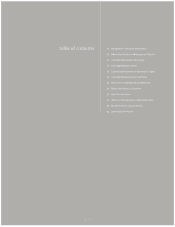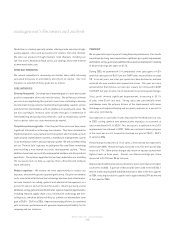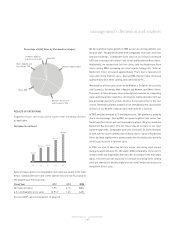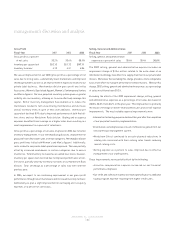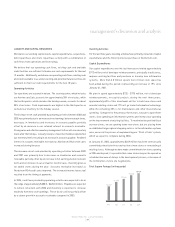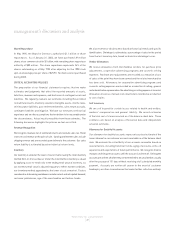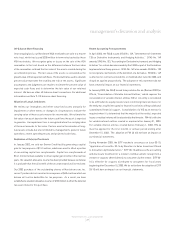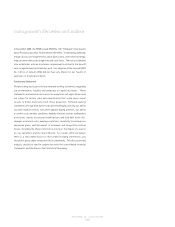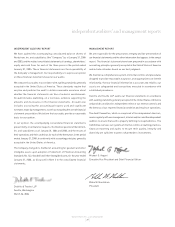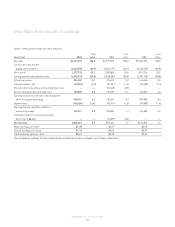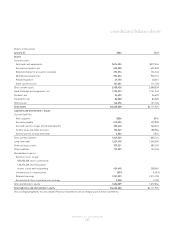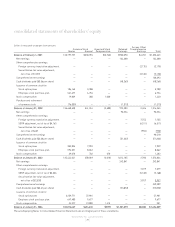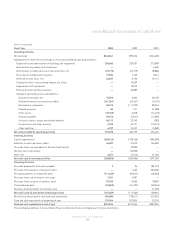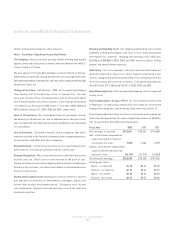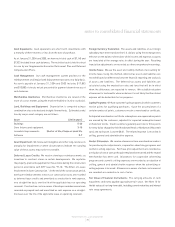Nordstrom 2003 Annual Report Download - page 25
Download and view the complete annual report
Please find page 25 of the 2003 Nordstrom annual report below. You can navigate through the pages in the report by either clicking on the pages listed below, or by using the keyword search tool below to find specific information within the annual report.Off-Balance Sheet Financing
On an ongoing basis, our Nordstrom VISA receivables are sold to a master
note trust, which has issued $200 million in term notes backed by those
VISA receivables. We recognize gains or losses on the sale of the VISA
receivables to the trust based on the difference between the face value
of the receivables sold and the fair value of the assets created during the
securitization process. The fair value of the assets is calculated as the
present value of their expected cash flows. The discount rates used to calculate
present value represent the volatility and risk of the assets. Significant
assumptions and judgments are made to estimate the present value of
expected cash flows and to determine the fair value of our retained
interest. We have no other off-balance sheet transactions. For additional
information see Note 9: Off-balance sheet financing.
Valuation of Long-Lived Assets
We review our intangibles and other long-lived assets annually for
impairment or when events or changes in circumstances indicate the
carrying value of these assets may not be recoverable. We estimate the
fair value of an asset based on the future cash flows the asset is expected
to generate. An impairment loss is recognized when the carrying value
of the asset exceeds its fair value. Factors used in the valuation of long-
lived assets include, but are not limited to, management’s plans for future
operations, recent operating results and projected cash flows.
Realization of Deferred Tax Assets
In January 2002, we sold our Denver Credit facility generating a capital
gain for tax purposes of $15.5 million, which was used to offset a portion
of our existing capital loss carryforwards. Capital loss carryforwards of
$16.1 million remain available to offset capital gain income in the next two
years. No valuation allowance reserve has been provided because we believe
it is probable that the full benefit of these carryforwards will be realized.
Our 2002 purchase of the outstanding shares of Nordstrom.com, Inc.
series C preferred stock resulted in an expense of $40.4 million which we
believe will not be deductible for tax purposes. As a result, we have
established a valuation allowance reserve of $15.8 million to offset the deferred
tax asset related to this purchase.
Recent Accounting Pronouncements
In April 2003, the FASB issued SFAS No. 149, “Amendment of Statement
133 on Derivative Instruments and Hedging Activities.” SFAS No. 149
amends SFAS No. 133, “Accounting for Derivative Instruments and Hedging
Activities” for certain decisions made by the FASB as part of the Derivatives
Implementation Group process. SFAS No. 149 also amends SFAS No. 133
to incorporate clarifications of the definition of a derivative. SFAS No. 149
is effective for contracts entered into or modified after June 30, 2003, and
should be applied prospectively. The adoption of this statement did not
have a material impact on our financial statements.
In January 2003, the FASB issued Interpretation No. 46 (Revised 2003) or
FIN 46, “Consolidation of Variable Interest Entities,” which requires the
consolidation of variable interest entities (VIEs). An entity is considered
to be a VIE when its equity investors lack controlling financial interest or
the entity has insufficient capital to finance its activities without additional
subordinated financial support. Consolidation of a VIE by an investor is
required when it is determined that the majority of the entity’s expected
losses or residual returns will be absorbed by that investor. FIN 46 is effective
for variable interest entities created or acquired after January 31, 2003.
For variable interest entities created before February 1, 2003, FIN 46
must be applied for the first interim or annual period ending after
December 15, 2003. The adoption of FIN 46 did not have an impact on
our financial statements.
During November 2003, the EITF reached a consensus on Issue 03-10,
"Application of Issue No. 02-16 by Resellers to Sales Incentives Offered
to Consumers by Manufacturers." EITF 03-10 addresses the accounting
and disclosure treatment for a retailer’s reimbursement receipt from a
vendor for coupons offered directly to consumers by the vendor. EITF 03-
10 is effective for coupons distributed to consumers for fiscal years
beginning after December 15, 2003. We do not believe the adoption of EITF
03-10 will have an impact on our financial statements.
NORDSTROM, INC. and SUBSIDIARIES
[23 ]
management’s discussion and analysis


